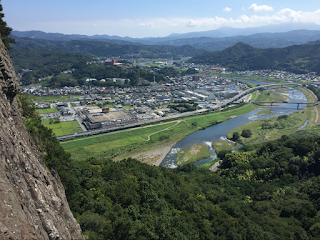Route Name: Battlerunner
(バトルランナー)
Mountain: Jōyama (城山)
Rock type:
Andesitic tuff
Length: 4 pitches (approx. 100m)
Jōyama
(城山) is a small rocky mountain at the
top of the Izu peninsula in Shizuoka prefecture, and is a well-known
rock-climbing venue with several hundred routes. Sitting across the river from
the town of Ōhito, its South face is home to some of its longest and best
multi-pitch routes. The rock quality on this slabby face is first-class, and
predominantly requires good balance and footwork as you float upwards from
small pocket to pocket.
One
of the most popular and striking routes at Jōyama is Battlerunner (バトルランナー),
a 4-pitch outing that takes a direct line up the middle of the face through the
large roof at mid height. With great climbing and plenty of exposure it really
is one of the finest routes around at its grade!
Getting
there:
If
travelling from Tokyo on public transport, the simplest way is to take a
shinkansen from Shinagawa (品川) to Mishima (三島),
and then change for a local Izu-Hakone-Sunzu train for Ōhito (大仁).
From there you can either walk to the trail-head in about half an hour, or take
a local taxi.
If travelling from
Tokyo by car, head down the Tōmei Expressway (with a convenient Starbucks located
at the Ashigara service area south of Mt Fuji), transfer onto the Izu Chuō-do
toll road, and stay on as far as Ōhito. Once on local roads in Ōhito, make your
way across the Karino river (狩野川) and down to a small
car park opposite the trail-head.
Description:
From
the trail-head a short walk of about 15 minutes will bring you to a signed
junction in the trail.
Head
right from here up a short scrambly path and you will come out at the bottom of
the South face. It’s a good idea to put your helmet on whilst near the base of
the rock in case of falling stones from above.
There
are a few bolted single pitch routes along the base of the face, and in high
season (Oct-May) it can get quite busy.
Battlerunner starts about midway along
and heads up towards an overlap just below and to the right of a tree-covered
terrace.
Approximate
pitch descriptions are as follows:
Pitch
1: Delicate slab climbing with good bolts up to the overlap, then climb the
bulge direct and continue up to a semi-hanging bolted belay below the first
small roof. (25m 5.8)
Pitch
2: Surmount the first roof then continue up steepening 5.9 slabs to a bolted
belay below the large roof. Climb the roof directly by a mix of underclings and
crimps, to get established on the wall above. Another 5-6m will bring you to a
bolted belay. (35m 5.10a)
Pitch
3: Climb easier but more run-out slabs to a bolted belay below the final pitch.
(20m 5.7R)
Pitch
4: Ascend the final delicate and run-out slabs, and anchor just below the
tree-covered ledge. (20m 5.9R)
Because
of the risk of knocking loose rocks down on the people below, the best way to
get down is to rappel straight back down the line of the route rather than
attempt to walk/scramble off from the top anchors. This can be done in two
rappels with 60m ropes.
Note
– The above is a fairly standard way of splitting the pitches, but it is
equally possible and maybe even preferable to end pitch 2 at the bolted belay
under the roof, and then climb the roof and pitch 3 in one.
Overall:
With
impeccable rock quality, superb balancy slab climbing and powerful moves
through the crux roof, this route deserves the three stars it gets in all the
Japanese guidebooks! A set of about 10-12 quickdraws will suffice.
The book is out now in print and kindle versions on Amazon.
Click / tap the photo to find out more:








No comments:
Post a Comment